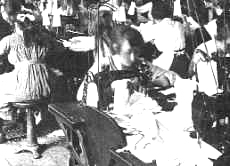
Machinists in Derry shirt factory
Photograph eproduced with the kind permission of
the Museums & Galleries of Northern Ireland
Men in office jobs in the mid nineteenth century created a demand for white cotton shirts with detachable collars and fronts that could be changed every day and William Scott of Derry responded to this demand. By 1851 his firm had expanded. Material was cut in his factory and sent to 'outworkers' in rural Derry, Tyrone and Donegal who sewed up the shirts, often working in groups called 'stations'. William Tillie introduced the sewing machine to Derry in 1856 and shirt-making moved to large factories. It was to become one of the most successful industries in Ireland.
There were 38 shirt factories in Derry in 1902, employing 18,000 workers, mostly women, at wages averaging nine shillings per week each and another 80,000 poorly paid outworkers. They produced over 700,000 shirts per week and a detachable collar industry exported millions of collars also.
Numbers employed declined in the twentieth century but shirt-making was the most substantial source of employment in Derry for well over a hundred years and the workforce could be up to 90 per cent female.
| Nothing has been of greater benefit to the small tenant farmer in this district than the shirt and underclothing work; his women can always earn something when they have time at their disposal, the money thus earned being often the only cash he sees for months at a time. It has helped to stave off emigration ... One can only regret that the home work industry is a dying one. Londonderry Sentinel, 19 Oct. 1912, quoted in Hilda McCafferty, The shirt tale, Derry, 1980. |
Apart from management and technicians who were mostly male, there were two skilled trades involved: cutters and machinists. A gender division of labour developed in Derry. Most employees were machinists. Theirs was a skilled trade with a learning period up to four years and it came to be constructed as women's work. There were fewer jobs in cutting, which was constructed as men's work, was better paid and enjoyed higher prestige. Cutters claimed their job was more skilled, responsible and dangerous. They were determined to maintain their wage advantage over the machinists, and women were generally unwelcome to join their ranks, although some did.
| ... The cutter said that some of his fellow-workers did not want to join the NUTGW simply because they perceived it as a 'woman's union'. The other suggestions were that cutters wanted to protect jobs from encroachment by women and that they wanted to make a separate bargain with employers on wages and conditions. Andrew Finlay, 'The cutting edge: Derry shirtmakers' in C. Curtin, P. Jackson, B. O'Connor (eds.), Gender in Irish society, Galway, 1987, p.98 |

Machinists in Derry shirt factory
Photograph eproduced with the kind permission of
the Museums & Galleries of Northern Ireland
Between 1920 and 1955 it was difficult for males to find secure jobs in Derry and women, often poorly paid, were the breadwinners in many homes, especially before social welfare arrived. Demands for industries that would provide jobs for men were supported by reference to the 'unnaturalness' of this situation and the embarrassment for husbands in being 'housewife men.'
Even when jobs were scarce, men seldom worked as machinists. Various explanations were given: women didn't want them; they wouldn't apply because they resented having to do women's work; managers thought women were better with their hands; managers thought little of men who applied for women's work and the work was badly paid. About thirty men were employed as machinists in one experiment in the 1960s and all went well for a while; however the project failed after two years. The shirt industry declined in Derry in the later twentieth century, mainly due to foreign competition.